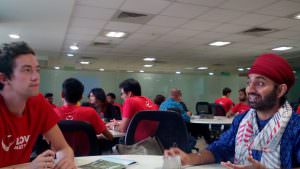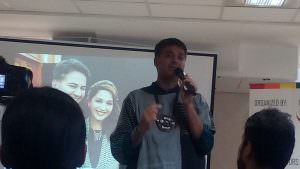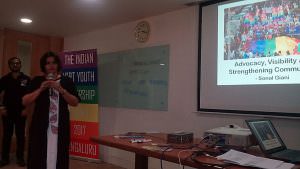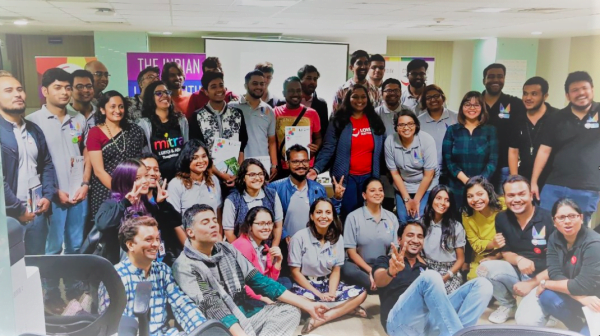The first time I realized I was queer, I was nine. I had no one to talk to and I did not know who else was like me. In a small town like mine, there was little awareness and much less support. Internet accessibility was rare in those days in a small town and I could not access information at a cyber cafe lest I was seen as a pervert.
I did not want to lose friends or the comfort of being in familiar surroundings. So when the situation began to evolve in a manner where I would be pushed out into the unfamiliar anyway, it felt like a kind of freedom.
During my late teens, I grew quite vocal about queer issues despite criticism and lingering fear. When I left my town to pursue higher education, it brought me in touch with a lot of people who did not find being queer repulsive. Sure not all of them were sensitized against gays or the hijra community, and problematic jokes and notions existed. The mere fact that I was surrounded by supportive voices gave me the strength I needed to explore myself.
With the advent of social media, I met others from the different sub-groups within the community. However, the turning point came in the United Kingdom (UK), where Lesbian, Gay, Bisexual and Transgender (LGBT) events are openly held and advertised. Expectations based on gender are relatively less there and I noticed how comfortable people were in expressing themselves outside of what was considered the norm.
In India, most queer discourse is seen in the form of protests or Pride marches.
This was the same at work. When one of my work colleagues exclaimed his disbelief that I was bisexual after I was seen at Pride and began asking awkward questions, he was quickly shut down by others. My boss and some other colleagues went out of their way to introduce me to their diversity policies and ensured I was okay, although I was just there part-time.
This made me a little sad that in India where despite a lot of queer discourse these days, most of it I had seen was in form of protests or Pride marches. People are often denied the similar participation of their straight colleagues where personal life meets the professional.
Hence the presence of queer people engaged in different fields of work from all over the country was a different experience for me. Mission for Indian Gay and Lesbian Empowerment (MINGLE) has been organizing this two-day event since 2014. Applicants are invited from India and the South Asia Association for Regional Cooperation (SAARC) nations, including foreigners who are settled in one of these countries.
One has to answer a set of questions based on which selection is done. This year there were 200 applications and 35 were selected, including me. With some trepidation and some excitement, I flew to Bangalore to attend the MINGLE summit on the 16th and 17th of December. The venue was at the ThoughtWorks campus in Koramangala.

I had really no idea what to expect when my partner showed me the call for applications to MINGLE’s Indian LGBT Youth Leadership Summit, 2017 (MYLS2017). Most of my professional interactions within the queer community have been from when I was in the United Kingdom. The fact that there was a workshop in India itself was incredible.
I was in a room full of people who were like me. The 35 participants encompassed queer individuals were from countries such as Sri Lanka, Oman and the US. This was not Pride or any kind of direct activism. It was a training session and a conference happening just like other conferences I had been to. That made a world of difference in how empowered I felt for the first time in my own country. The validation I felt was palpable.
Of course, what was more empowering was the fact that we were going to be in the presence of very successful professionals who were either queer or queer positive. There were corporate persons such as Parmesh Shahani of Godrej and Ritesh Rajani of IBM. On the other hand, there were non-corporate professionals such as life coach Kiran Gulrajani and author Vasudhendra Chanda.
Also Read: The Queer Question: Dispelling Myths Surrounding Queerness
As someone had once pointed out to me, in India, when one talks of queer professionals, the image that comes to mind is of someone associated with the fashion or entertainment industries. It has reached such a level of typecasting, that very often men who are perceived as “effeminate” are typically identified with either industry.
It was heartening to see that stereotype being broken right in front of my eyes. There was a range of discussions on inclusive measures within bigger companies on how to solve and conciliate disputes regarding queer identities at work. MINGLE 2017 also widened its discourse on support through subjects such as transgender rights and mental health of queer professionals.

However, the experience was not without its little hurdles. I have always been careful about disclosing my identity to people in and outside of the queer community. More than general queerphobia, this has been due to fear of biphobia in particular. It brings on a host of negative tropes that are portrayed in the context of bisexuality.
One of the awkward questions asked by my aforementioned ex-colleague was whether I liked sleeping around with multiple partners. Conflating bisexuality and pansexuality with polyamory is problematic. Media fetishization of bisexual and lesbian women adds to this.
Even within the queer community, I have faced accusations of “indulging” in straight privilege while keeping a foot in the closet. Support for women in the queer community requires understanding the intersection of misogyny and queerphobia. The same goes for transphobia. The need for a separate space for the Lesbian, Bisexual and Transgender (LBT) groups has been prevalent for quite a while.
During one of the more interactive sessions at the summit, we were put in groups and instructed to find out about our commonalities. It was an eye-opener to the amount of disconnect within the community itself. I was placed with three men who were gay and within minutes I realized one of them had a hard time relating to problems specific to the LBT community. As the only bisexual person with a transgender partner in the group, it fell on me to explain what was the gender binary and why looking beyond it was important.
The issues of the LBT community were detailed upon by Sonal Giani, a feminist and an actress. Prior to this, Suhail Abbasi had taken us down memory lane with a historical record of media representation of homosexuality in Indian communities both in and out of the country.
Giani, on the other hand, discussed some of the queer initiatives that were taken by women as well such as Birds of A Feather and Sappho for Equality. She was quick to address the fact that one also has to set aside their differences with others in a minority community to work towards a common goal.

Queer support in India still come with the baggage of “foreign conspiracy”, attached to it, due to its lesser outreach beyond urban areas. Looking back at my own journey from a small town, I realize none of it would be possible without finding the right kind of support.
I have been hesitant towards approaching counsellors for fear of being judged. Hence, turning to my queer and ally friends ha been the one source of help I have always had. Thanks to MINGLE 2017, I feel better knowing not only do I have help from a wider network of people, but that many of them are successful in their personal lives.
I have learnt not to take such experiences for granted as it goes a long way towards unfettering one’s personal progress. I hope to take such support to smaller towns such as the one I had grown up in, so that queer individuals there can access such initiatives for themselves without that hampering their work-life.
Also Read: Amra Odbhut Café: A Community Space Realizing Kolkata’s Queer Utopia
About the author(s)
A queer activist, feminist and former lawyer with an active interest in humanitarian causes. She loves photography, revising her Spanish lessons, studying cultures and history, and travelling (or reading about it when she can't).




